Suzuki SV1000/S Maintenance Schedule and Service Intervals
This is the maintenance schedule and associated service intervals for the Suzuki SV1000 and Suzuki SV1000S. The Suzuki SV1000 and the half-faired SV1000S are sport motorcycles made by Suzuki since 2003, but which were discontinued after a few years as Suzuki focused on their GSX-R1000.
The SV1000’s engine is sourced from the Suzuki TL1000S, which never sold well itself (though is now a cult classic). Suzuki made over 300 changes to improve low-end and midrange performance.
So both the SV1000 and SV1000S have a 996 c 90-degree water-cooled fuel-injected engine that makes 89 kW (120hp) @ 9000 rpm at the rear wheel, and 102 Nm (75 lb-ft) at 7200 rpm. All in all, quite a lot of power in a very accessible powerband, and totally adequate for a bike with a wet weight of around 210-220 kg (different sources).
The SV1000S in particular was designed to compete directly with the Honda VTR1000F (also known as the SuperHawk or FireStorm, depending on the market), which was released before the Suzuki, and Ducati V-twin superbikes.
The SV1000 is the larger sibling to the popular 650 cc SV650 motorcycle. The SV1000 shares many common parts with the SV650, including all bodywork (front fairing, fuel tank and rear plastics/subframe), but the main frame, handlebars, swingarm and forks are different.
This site has links for things like oil and spark plugs from which we earn a commission (which unfortunately nobody can save, not even us). If you appreciate this work, then please use those links. Thanks!
Suzuki SV1000/S Service Intervals
Generally, the service intervals for the Suzuki SV1000 are:
- Change the oil every 37,50 mi (6,000 km) or 6 months. Use judgment if/when you’ve only been riding it a little. Every three services, change the oil filter.
- The valve service is every 15,000 miles or 24,000 km.
- Change fluids and/or rubber parts every 2-4 years, as specified.
Be sure to regularly check, clean, lubricate, and adjust the chain.
Suzuki SV1000 Maintenance Schedule
Below is the maintenance schedule for the Suzuki SV1000 and SV1000S.
Notes:
- The schedule has both time- and distance-based intervals. Observe the earlier of the two.
- I = Inspect and clean, adjust, replace or lubricate as necessary, R = Replace, T= Tighten
- If you track your bike or ride it hard, you may need to service it more often.
- The break-in schedule isn’t shown as this bike is broken in.
| mi x 1000 | 3.75 | 7.5 | 11.25 | 15 | |
|---|---|---|---|---|---|
| km x 1000 | 6 | 12 | 18 | 24 | |
| Months | 6 | 12 | 18 | 24 | Every |
| Engine oil (10W-40 Jaso MA spec, e.g. Motul 7100 10W-40) | R | R | R | R | |
| Engine oil filter (HF138RC) | R | ||||
| Air cleaner element (K&N SU-6503) | I | I | R | I | |
| Valve tappet clearance | I | ||||
| Spark plugs (NGK CR8EK are popular) | I | R | I | R | |
| Exhaust pipe bolts and muffler bolts | T | T | |||
| Fuel hoses | I | I | I | I | 4 years: R |
| Engine idle speed | I | I | I | I | |
| Throttle cable play | I | I | I | I | |
| Throttle valve synchronization | I | I | |||
| PAIR (air supply) system | I | I | |||
| Engine coolant (Ethylene glycol pre-mix) | 2 years: R | ||||
| Radiator hose | I | I | I | I | |
| Clutch hose | I | I | I | I | 4 years: R |
| Clutch fluid (DOT 4 only) | I | I | I | I | 2 years: R |
| Drive chain (Motul chain care kit) | I | I | I | I | 600 mi / 1000 km: C/L |
| Brake pads (2 pairs FA148HH up front, 1 pair FA174HH rear) | I | I | I | I | |
| Brake hoses | I | I | I | I | 4 years: R |
| Brake fluid (Castrol DOT 4) | I | I | I | I | 4 years: R |
| Tires | I | I | I | I | |
| Steering (grease bearings with lithium soap-based grease) | |||||
| Front fork | I | I | |||
| Rear suspension | I | I | |||
| Chassis bolts and nuts | T | T | T | T |
Tyre size and tyre pressure for the Suzuki SV1000
The manual specifies the following tyre pressures and sizes for the Suzuki SV1000 and SV1000S. They recommend Michelin Pilot Roads, or other street-oriented tyres.
| Tyre | Size | Tyre pressure (cold) |
|---|---|---|
| Front | 120/70 ZR17 58W | 36 psi/250 kPa/2.5 bar |
| Rear | 180/55 ZR17 73 W | Solo: 36 psi/250 kPa/2.5 bar Dual: 42 psi/290 kPa/2.5 bar |
Maintaining your Suzuki SV1000’s Chain
Maintain your chain regularly. Either use a good-quality (and affordable) chain lube like Motul Chain Paste, or use a full Motul Chain Care Kit to clean and restore a chain.
Suzuki recommends that you maintain your chain regularly according to the following schedule.
| Chain maintenance item | Every |
|---|---|
| Check chain * Correct tension / slack (20-30mm / 0.8-1.2 in at loosest point) * Adequate lubrication * No excessive wear / damage | Ride (pre-ride check) |
| Clean and lubricate chain | 1000 km / 600 miles |
| Inspect wear and general condition, including of sprockets | Service |
Damage includes loose pins, damaged rollers, dry or rusted links, kinked or binding links, excessive wear, and improper adjustment.
To check the slack on the Suzuki SV1000, put it in neutral, onto its kickstand, and on a level surface. Find the point where the slack is loosest — check multiple places (move the motorcycle forwards and backwards). Check the slack on the lower part of the chain, midway between the sprockets.
Slack on the Suzuki SV1000 is defined as the free vertical movement of the chain.
Target chain slack for the SV1000 / SV1000S: 20 – 30 mm (0.8 – 1.2 in)
If the chain slack is out of spec, you need to adjust it.
Adjusting chain slack
To adjust the chain slack on the Suzuki SV1000, follow the steps below. There should be no weight on it (no saddlebags / luggage).
- Loosen the rear axle (using a breaker bar) and the adjuster lock nuts on either side of the axle.
- Turn the adjuster nuts to tighten (or loosen) the chain. Keep checking the chain tension to see if it has come within spec.
- Keep an eye on the adjuster alignment marks on either side of the axle. Make sure that the adjustment is to the same point.
- When you’re done, tighten the axle to 100 Nm / 72.5 lb-ft.
- Re-check the chain slack again to make sure it’s still within spec.
About the Suzuki SV1000 / SV1000S
The Suzuki SV1000 was meant to be a “big” version of the SV650. But it never really was as popular as the SV650, mostly because it was a bigger bike that also didn’t have the premium-spec component of its contemporary sibling, the first GSX-R1000 (and especially the K5 GSX-R1000, which appeared during the SV1000’s tenure).
The engine in the SV1000 made over 90kW or 120bhp at the rear wheel when it first appeared in the Suzuki TL1000S. The SV1000 didn’t have the same tuning. Suzuki claimed 90 kW/120hp at 9000 rpm at the crank, which translated to a lower figure at the wheel. So the SV1000 never captured the imagination of the TL1000S-loving crowd from the outset.
Thankfully, this power figure is enough, as it’s a torquey bike. But you still need an exhaust and a tune if you want to get the full potential out of the SV1000.
One huge advantage of the SV1000 and SV1000S over its most obvious competitor, the Honda VTR1000F Firestorm/SuperHawk is that it’s fuel-injected. This means it’s easier to tune (with the right equipment), more reliable, and less likely to gunk up if you leave it sitting for a while.
The suspension for the SV1000 is also decent. It has fully adjustable cartridge forks (that are non-inverted mind you) and a fully adjustable rear shock (that is, preload, compression damping, and rebound damping on both ends). That’s great! It’s a lot more than you get on most bikes. People only modify the suspension if they’re serious racers, in which case this wouldn’t be most people’s first choice of bike — they would have opted for the K5 GSX-R1000 of similar vintage.
That said, the SV1000’s front fork was of a non-inverted style — lower in spec than bo the TL1000S and the GSX-R1000. Another hint that the SV1000 wasn’t the most premium bike in Suzuki’s line-up.
There were minimal changes to the SV1000 during its tenure. In 2005, Suzuki made some cosmetic changes, but also improved the engine with larger throttle bodies, higher-lift cams, a lighter flywheel, a higher compression ratio, and a new ECU. In 2006 there were just a few new colours released.
Manual for the Suzuki SV1000
The above maintenance schedule comes directly from the user’s manual for the Suzuki SV1000, with additional notes from the service manual.
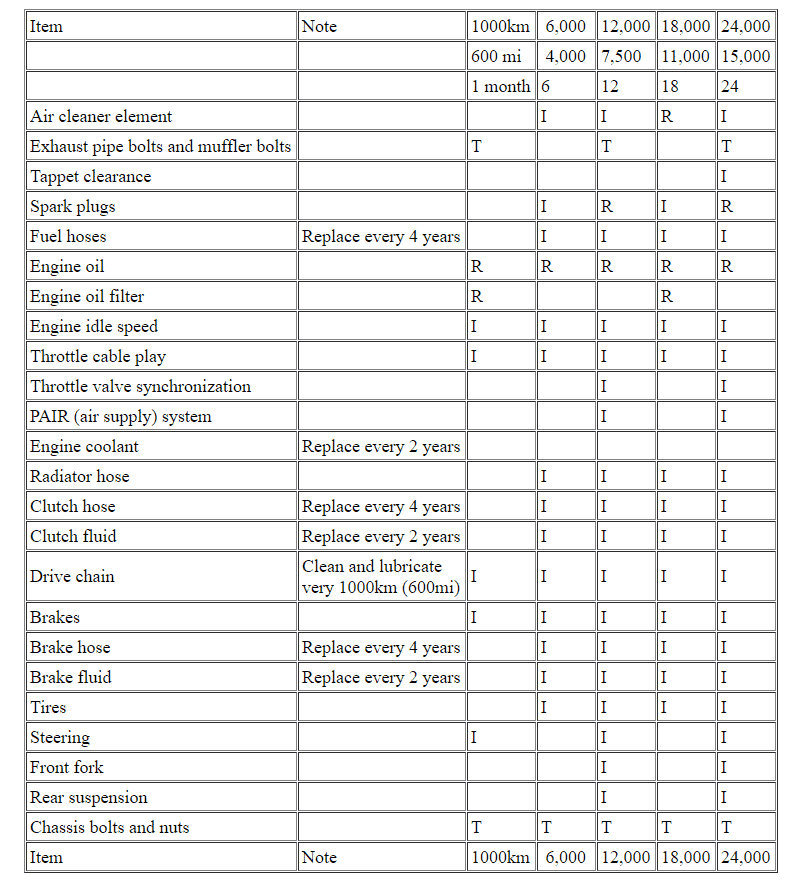
You can download it from here.
The section on regular maintenance from the service manual is below for reference.
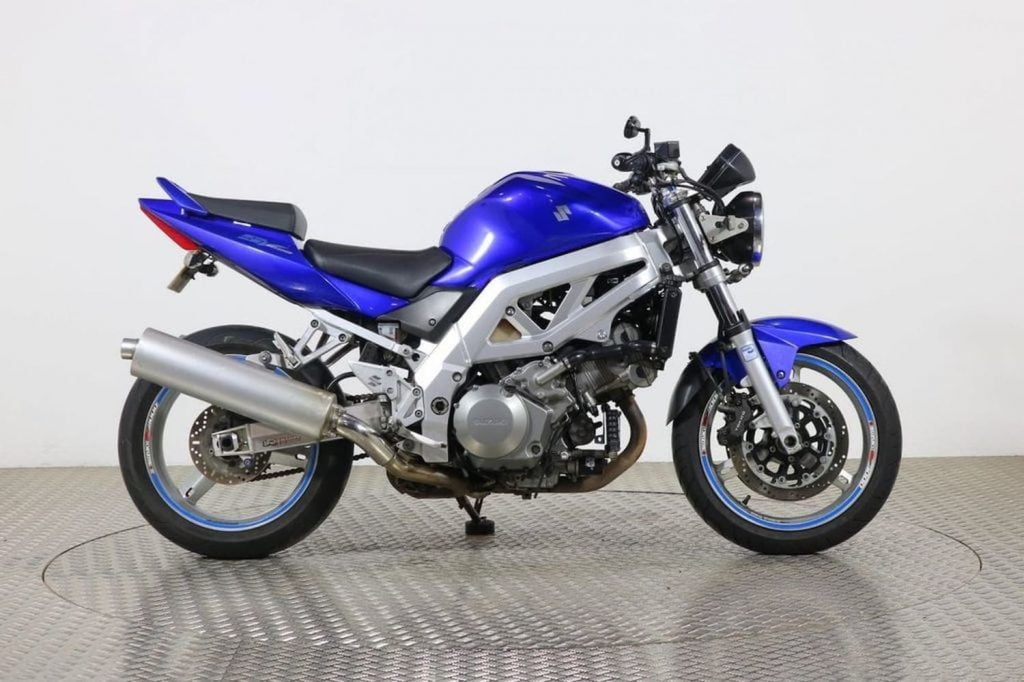
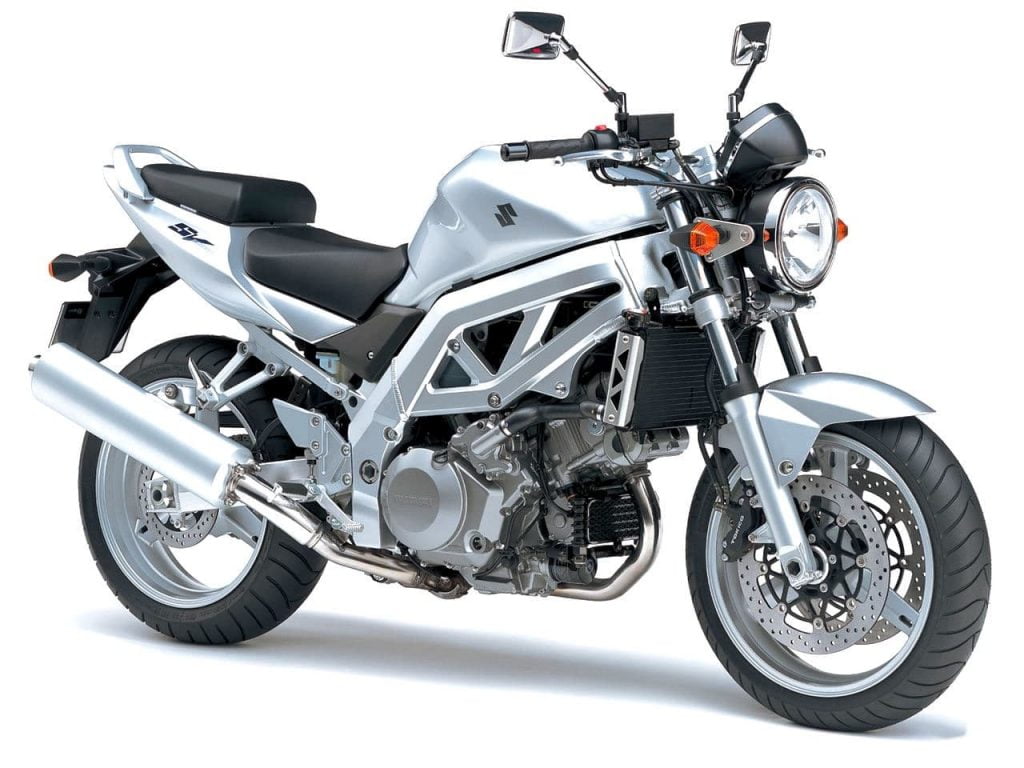
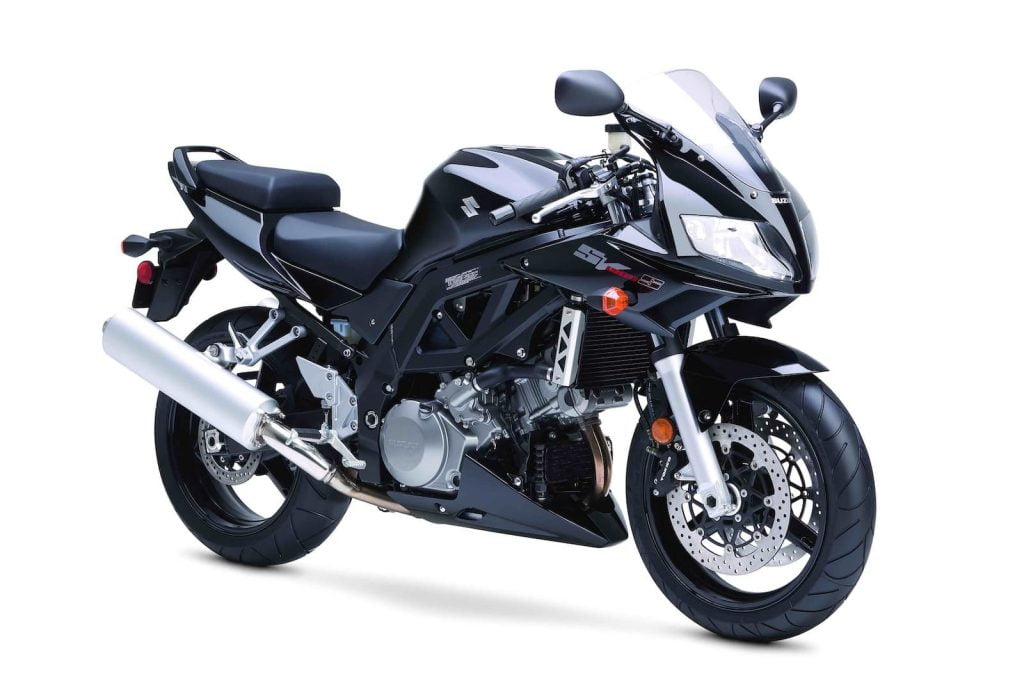
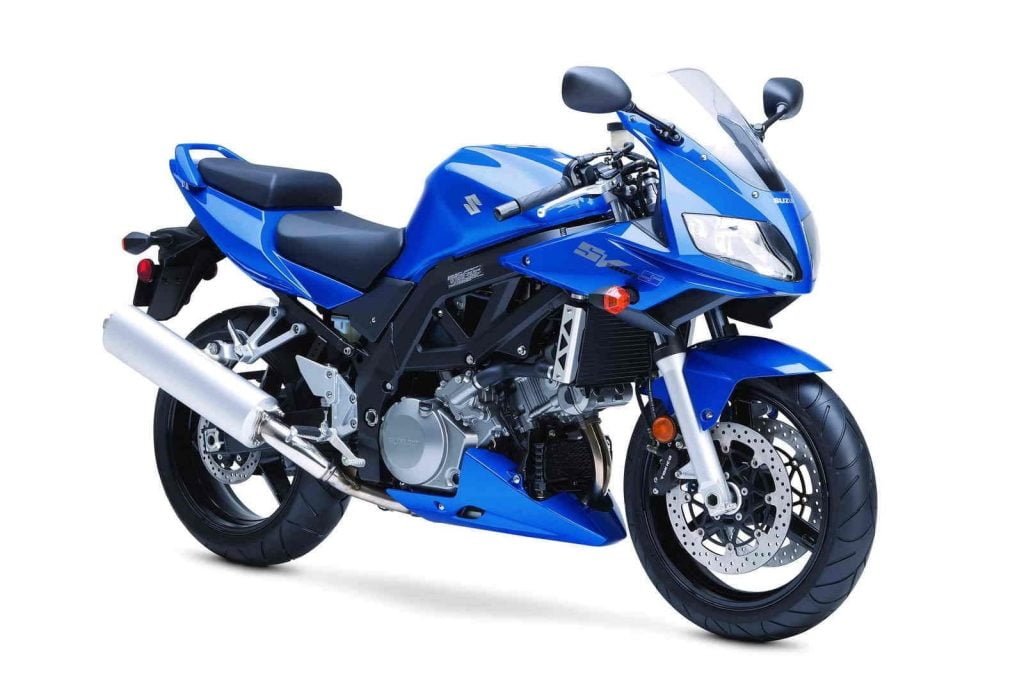
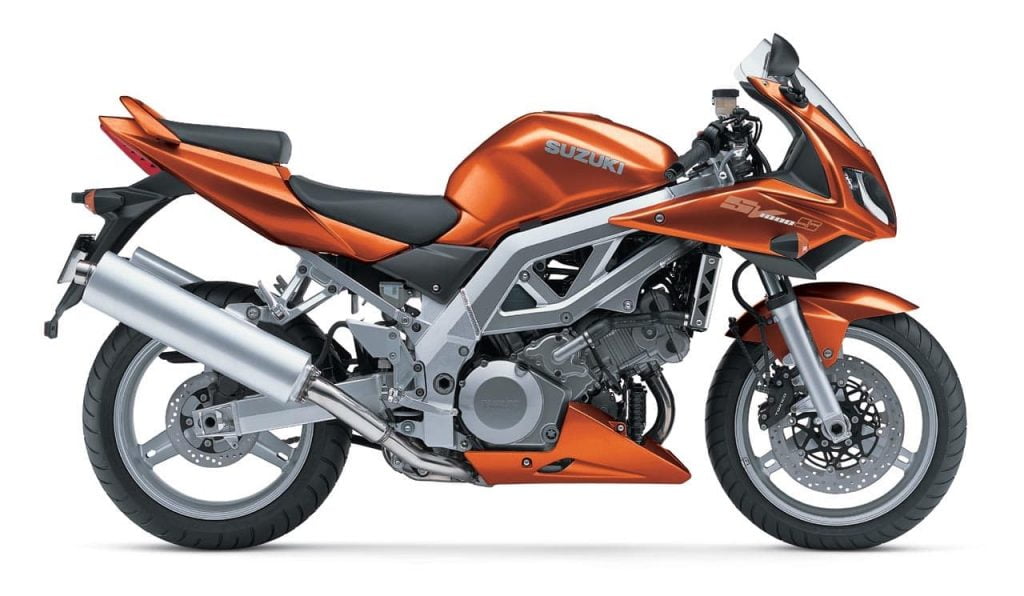
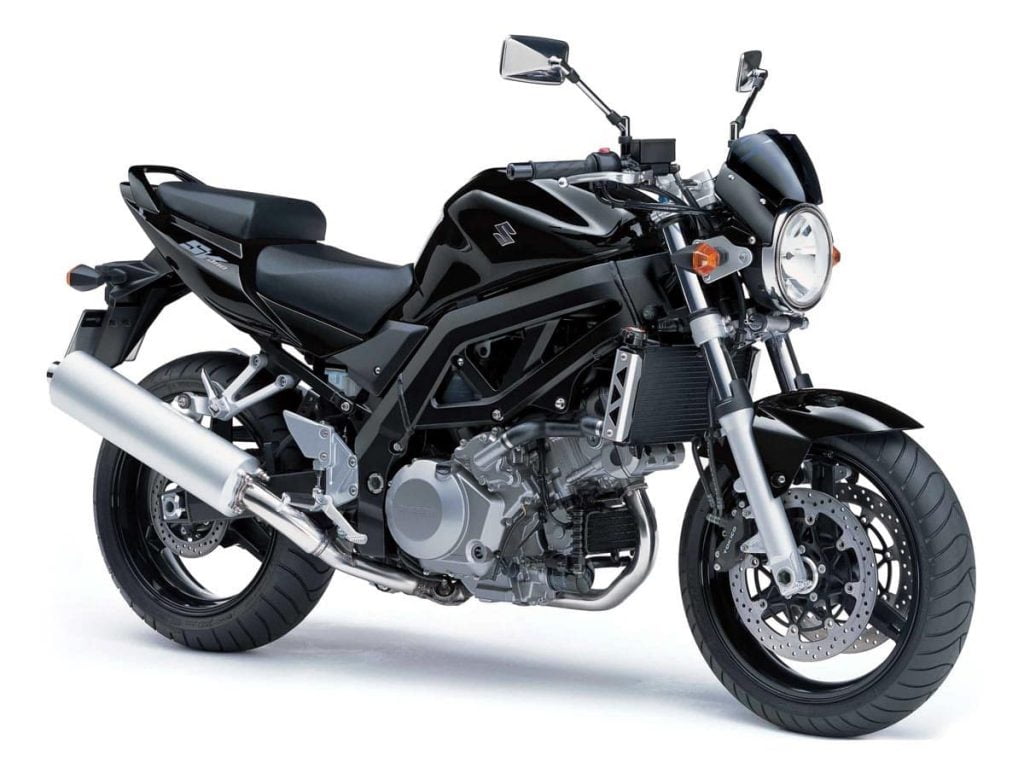
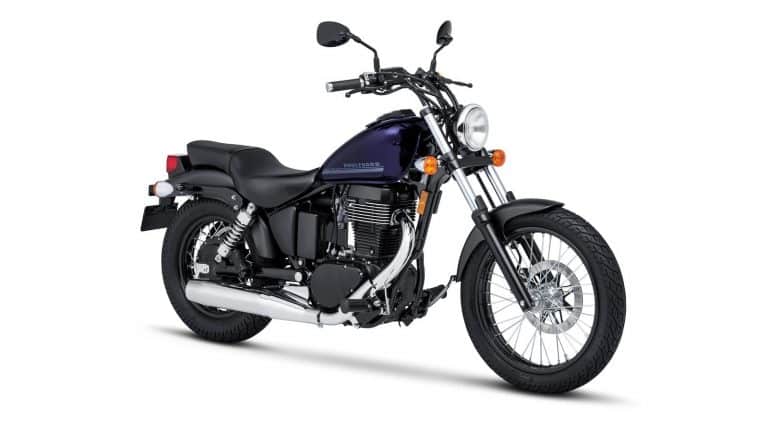
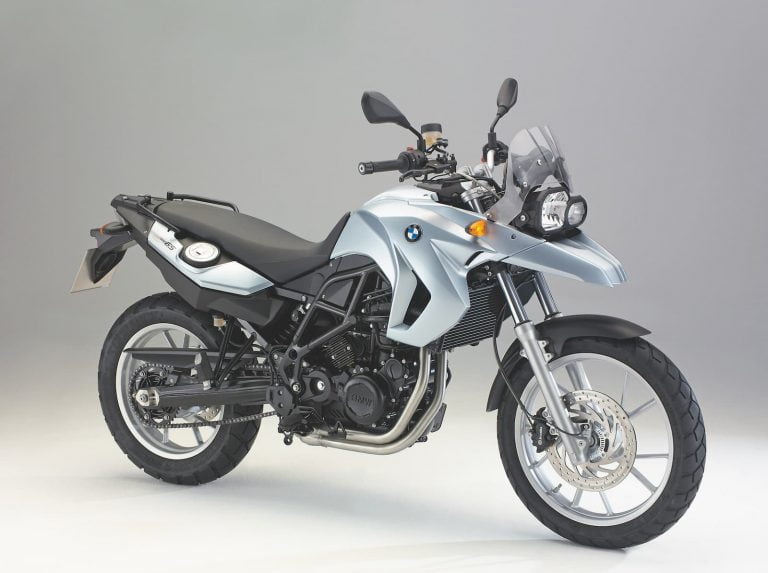
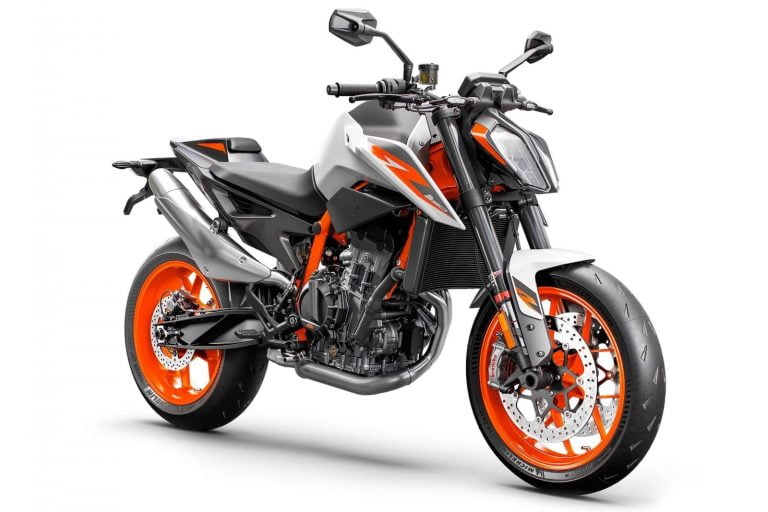
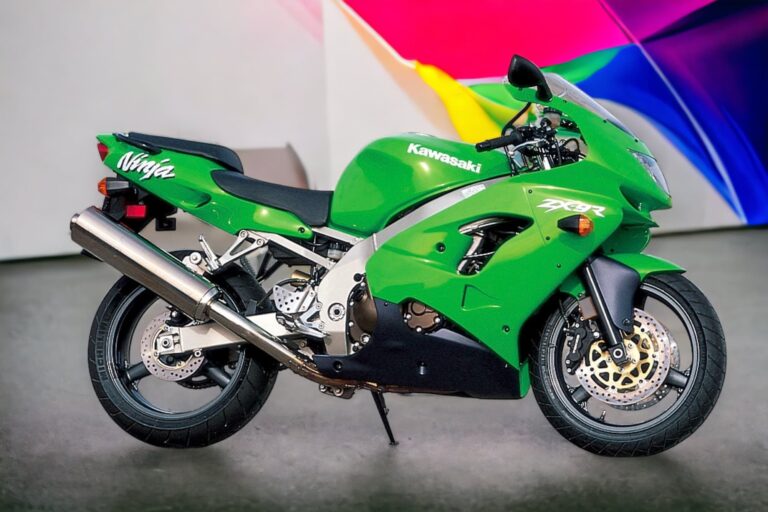
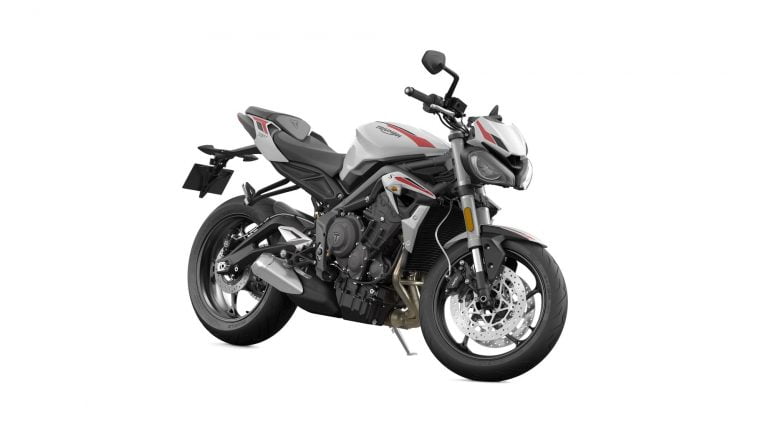
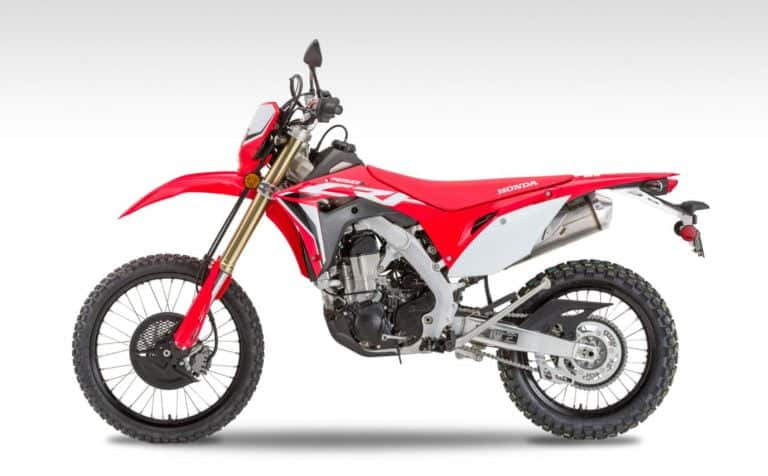
This tables make zero sense. Are you saying that you need to change oil and filters every 600mls – that’s nuts.
I went yesterday for a short ride and did 300mls; according to you I would have to change my oil and filers every bloody weekend.
Hi Gabriel, I agree, that would be nuts! It’s every 3750 miles / 6000 km for oil changes for this bike (and many Suzuki liquid-cooled bikes). 600 miles is the recommended distance for cleaning / lubing the chain.
I’m not sure where you got 600 from, went over this page again for errors.
Happy riding on a great bike.